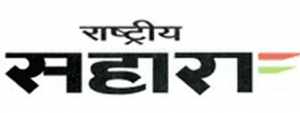
18-05-2017 (Important News Clippings)
To Download Click Here.
देश को तीन टाइम जोन में बांट देना चाहिए
वक्त है। (ये लेखक के अपने विचार हैं।)
Date:18-05-17
रूस पर भारत की परमाणु कूटनीति का दबाव
भारत ने प्रधानमंत्री नरेंद्र मोदी और रूसी राष्ट्रपति ब्लादीमीर पुतिन की अगले महीने होने वाली मुलाकात से पहले रूस पर परमाणु कूटनीति का कड़ा दबाव बनाकर यह जता दिया है कि जब दुश्मनों पर दबाव डालने से काम न बने तो दोस्तों से नाराजगी जताने का तरीका भी अपनाया जाना चाहिए। भारत के इस रुख ने चीन से नज़दीकी बढ़ा रहे रूस के भीतर बेचैनी पैदा कर दी है और संभव है कि वह भारत के पक्ष में कुछ सक्रियता दिखाए। रूस को उम्मीद थी कि भारत पुतिन और मोदी की मुलाकात से पहले कुडनकुलम में एटमी रिएक्टर विकसित करने संबंधी सहमति पत्र (एमओयू) पर रूस के साथ समझौता कर लेगा लेकिन, भारत ने कह दिया है कि अगर उसे डेढ़ दो साल में परमाणु आपूर्ति समूह (एनएसजी) का सदस्य नहीं बनाया जाता तो उसके पास अपना रिएक्टर विकसित करने के अलावा कोई रास्ता नहीं बचेगा। रूस इस समझौते के लिए बहुत बेचैन है, क्योंकि इससे उसे व्यापारिक लाभ होगा। इस सिलसिले में रूस के उप प्रधानमंत्री डिमित्री रोगाजिन ने मोदी से मुलाकात भी की है लेकिन, कोई बात बनती नहीं दिखी। भारत को परमाणु ऊर्जा से बड़ी उम्मीदें रही हैं और सरकार का दावा है कि वह 2024 तक परमाणु ऊर्जा का उत्पादन 15000 मेगावाट तक पहुंचा देगा जो कि पिछले दशक के उत्पादन का तीन गुना होगा। रूस पर भारत के दबाव डालने की एक वजह चीन की वन बेल्ट वन रोड(ओबीओआर) योजना में रूस का चीन के करीब जाना है। इस बीच उसने पाकिस्तान से सामरिक करीबी भी कायम की है। येे दोनों कदम भारत के हितों के विरुद्ध हैं। इसके बावजूद रूस जैसा पुराना मित्र जो ब्रिक्स का सदस्य भी है वह भारत के लिए उपयोगी हो सकता है अगर परमाणु ऊर्जा के क्षेत्र में चीन पर दबाव बनाकर भारत को एनएसजी में शामिल करा सके। भारत ऐसी शर्त अमेरिका और फ्रांस से भी रख सकता है लेकिन, शायद वे उतने पुराने मित्र नहीं हैं जितना रूस, इसलिए उनसे वह उतनी उम्मीद नहीं कर सकता जितनी रूस से। आज के अंतरराष्ट्रीय संबंध व्यावसायिकता से शुरू होकर सामरिकता की ओर जाने वाले हो गए हैं और भारत आर्थिक संकट से गुजर रहे रूस के लिए अपार व्यापारिक संभावनाएं रखता है। अब देखना है कि इस दबाव का रूस पर कितना असर पड़ता है और वह चीन को भारत के पक्ष में व्यावहारिक रास्ता अपनाने के लिए कितना मजबूर करता है।
जैव प्रौद्योगिकी नियामक

After the no-show
Refusal to engage cannot be long-term policy. India must frame a response to China’s Belt and Road initiative
It’s a pity that India’s common interest with China on connecting the shared neighbourhood has not translated into Delhi’s support for Beijing’s ambitious Belt and Road Initiative. Delhi’s decision to turn its back on this week’s Belt and Road Forum in Beijing underlines the enduring tragedy of Sino-Indian relations. Deep distrust spawned over the decades by unresolved territorial disputes, intensifying competition for regional influence and fears of mutual encirclement through alliances with third parties have been reinforced by recent difficulties over trade and growing divergence on multilateral issues like nuclear order, terrorism, Asian security architecture and governance of the global commons. That list has just got a little longer with the addition of the BRI.It has been no secret that India was deeply wary of President Xi Jinping’s Belt and Road Initiative — the collective name for Beijing’s expansive plans to connect the Eurasian landmass and the Indian-Pacific littoral through trans-border road and rail networks, oil and gas pipelines, industrial corridors and inter-linked production chains backed by Chinese capital. Yet, Beijing was hoping that official India would participate at some level in the Belt and Road Forum. The quiet bilateral effort to facilitate India’s presence at the Forum was apparently unsuccessful. Hours before Xi opened the Forum, India announced its decision not to join and explained its decision by laying out three sets of concerns.
One was about the China-Pakistan Economic Corridor transgressing India’s sovereignty in Pakistan occupied Kashmir. Second, while India’s concern on PoK was well-known, Delhi surprised everyone by putting out a short but succinct critique of China’s BRI by pointing to the lack of transparency, underlining the questionable economics, and highlighting the negative impact on communities and nations hosting BRI projects. Third, Delhi expressed its displeasure at the air of haughty unilateralism surrounding Xi’s initiative.
The Belt and Road Forum has adjourned on Monday, but the issues dividing India and China on the question of connectivity and regional integration will stay. India’s long-term response to the BRI must be three-fold. One, Delhi must impart greater energy and urgency to its own internal and regional integration projects. For the gap between India’s rhetoric on connectivity and performance on the ground has been too wide. Two, Delhi must match its criticism of Chinese political and financial terms for connectivity projects with the demonstration of a different Indian model that is less hegemonic and more in sync with global norms. Three, Delhi must continue to press Beijing for a sustained dialogue on connectivity that will not only minimise the current contentions but also address the deeper questions on territorial sovereignty and regional rivalry that have been greatly reinforced by China’s Belt and Road Initiative.
A bumper farm crisis
A free market in agriculture can be the best antidote to crisis facing our farmers
Farmers in some States are regretting their abundant yields this year as the prices of agricultural commodities have crashed. Chilli farmers in Andhra Pradesh and Telangana, tomato growers in Karnataka, and toor dal cultivators in Maharashtra are at the centre of a severe crisis that has witnessed prices fall by more than half in a matter of just weeks. Some speculate that high commodity prices last year caused farmers to respond by boosting production, which in turn led to the present price crash.
Whether it is the wholesale mandis where farmers sell their agricultural produce, or retail outlets where consumers buy them, price fluctuations are common. But whether such fluctuations can be explained as being due to mindless crop cultivation, as some speculate, is not as certain. For one, in the consumer market, commodity speculators usually dampen price fluctuations by managing supply according to consumer demand. For instance, when the supply of grains is abundant, speculators do not flood the market with all their stock but instead hoard the grains and sell them later when supply turns scarce. Thus, even if farmers engage in mindless grain production, speculators usually save the day for consumers by preventing steep rises and falls in grain prices.
Second, in the wholesale market, speculators can save farmers from similar price fluctuations by paying a competitive price for their produce even when there is abundant supply. Grain traders, to return to our previous example, who want to hoard supply expecting higher grain prices in the future would be willing to pay a better price to farmers today. This comes not out of compassion for farmers, but purely out of competition with other grain traders. When farmers are free to sell their produce to any trader they want, it is traders paying the best price who get hold of it. Farmers can also expect a more predictable price for their produce each season, reflecting stable consumer prices, thus preventing mindless cultivation.
Such competition though is precisely what is missing from the Indian agricultural scene where the supply chain is broken. Red tape, including limits on stocking agricultural products, has prevented the growth of a robust market for commodity speculation. The result is lack of investment in infrastructure like that of cold storage; about 40% of agricultural produce in India is wasted because of it. This, in turn, has led to price fluctuations that have affected both the farmer and the consumer. Wholesale agricultural prices are determined by trader cartels that block competitive bidding. This significantly reduces the price farmers can get for their products, while boosting the profits of some privileged traders. By some estimates, farmers receive only 20-25% of what the final consumer pays for his product. Thus, a free market in agriculture can be the best antidote to the crisis facing Indian farmers.
Date:17-05-17
New base, new basket
The revised IIP shows India may have been overstating the industrial slowdown in its economy
The Index of Industrial Production (IIP), a critical economic indicator, has of late become a source of concern — sometimes unmerited — over the credibility of India’s statistics. The bellwether high-frequency indicator is a key input into making and assessing policies, particularly those pertaining to the manufacturing sector, inflation, interest rates and the flow of credit in the economy. But, in the past few years, the month-on-month IIP has shown excessively low, and even negative growth, which subsequently turned out to be out of sync with the actual manufacturing output growth measured through the Annual Survey of Industries (ASI). The survey for a financial year comes with a lag of about 24 months.
The theoretical aim of the IIP is to capture the direction and the trend of industrial production in the country, not the absolute value of industrial production. Its chief utility is as an early indicator of turning points in the economy. The IIP has been failing in serving this purpose. The reason being that it was measuring industrial output using baskets of production items and producing entities that had remained unchanged since 2004-05. The standard procedure followed was that a list of items was constructed in the base year and for each item the producing entities were identified. This structure was frozen. The index was constructed with the output figures received month over month from the baskets of items and entities fixed in the base year. If an entity shut down, its output fell to zero. But since the basket was frozen no new entity could be taken in place of the zero-output one. Over time, an item, say calculators, may fall out of use and more smartphones may be consumed. The IIP was not equipped to capture such changes in the economy.
A more dynamic indexNaturally, the IIP growth acquired a certain directional bias, which impaired its usefulness. To overcome the weaknesses, the IIP is being made more dynamic. First, the Central Statistics Office has updated its base year to 2011-12. The revision, the ninth such exercise since the original base year choice of 1937, is aimed at capturing the changes that have taken place in the industrial sector since 2004-05. New products have been included in the items basket, and those that have lost their relevance deleted. Renewable energy, for example, has been included in the electricity index. The expanded coverage — 809 items against 620 earlier, and a larger number of factories — is expected to make the IIP more representative.
Second, instead of the periodic baskets revisions, a permanent standing arrangement is being put in place to make sure that the IIP remains representative. An ongoing process is to be instituted for monitoring and mapping into the index the changes taking place in the economy under which a technical committee will continuously review the item basket, the reporting entities and the method of coverage.
The improvements in the statistical apparatus have been carried out on the recommendations of a committee that the United Progressive Alliance (UPA) government had constituted in 2012 under the chairmanship of late Saumitra Chaudhuri, a member of the Economic Advisory Council of Prime Minister Manmohan Singh. Several measuring difficulties remain, though. The process of physically collecting data from entities to establish the collection system, where no statutorily-mandated system of regularly reporting production is in place, is still an institutional challenge.
The updated IIP offers new insights, the most important being that India may have been overstating the industrial slowdown in its economy. Whereas the average industrial output growth of the last five years (2011-12 to 2016-17) in the old IIP is 1.38%, in the updated series it is 3.8%. On the manufacturing front, the news gets even better. The average five-year growth has improved to 4.04% against 0.94% in the old IIP. Although the average growth in two of the five years in which UPA-2 was in office outpaced that in the three years of the incumbent National Democratic Alliance (NDA) government’s tenure. The performance — 4.2% versus 3.9% — challenges the narrative of the ‘policy paralysis’ characterising the dying years of Dr. Singh’s stint. It also tests the efficacy so far of Prime Minister Narendra Modi’s ‘Make in India’ initiative.
The bad news is that the output growth of the infrastructure and construction sector has slowed down from 5.7% in 2013-14 to 3.8% in 2016-17 despite the NDA government’s sustained push to the infrastructure sector, including through substantial increases in targeted public spending, in the last three years. The updated IIP also shows a modest recovery in the capital goods sector, a barometer of the investment sentiment. From -3.6% in 2013-14, output growth in the sector improved to 1.9% in 2016-17.The main driver of growth in the economy remains consumption. Consumer durables grew 6.2% and non-durables 9% in 2016-17. The Seventh Pay Commission award to Central government employees and pensioners last year seems to have spurred consumption. The monthly figures have not been released, but the spurt could also have been triggered by hectic use of demonetised cash for acquiring consumer durables and non-durables.
Demonetisation’s debilitating impact on manufacturing is visible in the updated monthly IIP for 2016-17. The average output growth for the seven months from April to October was 6.8%, and for the five months from November to March 2.28%. The IIP’s coverage by design is limited to the organised sector. The disruption in the unorganised sector is expected to get measured in the ASI.The base years of all the major macroeconomic indicators, the Gross Domestic Product (GDP) and the Wholesale Price Index, are now aligned — 2011-12. The revised IIP will be plugged into the GDP series. The revised GDP estimates are scheduled to be released on May 31.
Puja Mehra is a Delhi-based journalist
सिल्क रूट का जाल
चीन की सरकारी मीडिया को देखें तो वह ‘‘वन बेल्ट वन रोड’ या ओबीओआर के लिए आयोजित सम्मेलन की सफलता पर फूले नहीं समा रहा है। वहीं दूसरी ओर भारत के उसमें शामिल न होने को लेकर छींटाकशी की जा रही है। वास्तव में यदि 29 देशों के प्रमुख और करीब 100 देशों और संगठनों के प्रतिनिधियों ने उस सम्मेलन में शिरकत किया तो तत्काल उसकी सफलता को दर्शाता है। दक्षिण एशिया में भारत और भूटान को छोड़कर सभी देशों ने भाग लिया। नेपाल ने तो बाजाब्ता वहां जाने के पहले इससे संबंधित समझौते पर हस्ताक्षर किया और ट्रांस बोर्डर रेलवे के विकास पर बातचीत कर रहा है। किंतु इन सबसे यह मान लेना की भारत का सम्मेलन से अलग रहना सही निर्णय नहीं था या वह अलग-थलग पड़ गया है उचित नहीं होगा। सबसे पहले हम यह याद रखें कि चीन पाकिस्तान आर्थिक गलियारा या सीपैक जो शिकियांग से ग्वादर बंदरगाह को जोड़ता है; वह पाक अधिकृत कश्मीर से गुजर रहा है। इसका भारत ने मुखर विरोध किया है, क्योंकि इसके द्वारा चीन प्रकारांतर से उस भाग पर पाकिस्तान के कब्जे को मान्यता दे रहा है। चीन को हमारे विरोध से कोई सरोकार नहीं है। जाहिर है, उसमें शामिल होने का मतलब होता चीन और पाकिस्तान के उस सहकार को मान्यता देना। इसलिए भारत के पास एक ही विकल्प था कि वह सम्मेलन से अपने को दूर रखे। ओबीओआर परियोजना को चीन करीब 1000 वर्ष पूर्व कायम सिल्क रूट या रेशम मार्ग को पुनर्जीवित करना कह रहा है। उसकी इस प्रस्तावित ओबीओआर के दो रूट होंगे। पहला जमीनी रास्ता चीन को मध्य एशिया के जरिए यूरोप से जोड़ेगा, जिसे कभी सिल्क रोड कहा जाता था। दूसरा रूट समुद्र मार्ग से चीन को दक्षिण पूर्व एशिया और पूर्वी अफ्रीका होते हुए यूरोप से जोड़ेगा, जिसे नया मैरिटाइम सिल्क रोड कहा जा रहा है। इसे दक्षिण चीन सागर के जरिए इंडोनेशिया, बंगाल की खाड़ी, श्रीलंका, भारत, पाकिस्तान, ओमान के रास्ते इराक तक ले जाने की योजना है। पाक से साथ बन रहे सीपेक को इसी का हिस्सा माना जा सकता है। इसका उद्देश्य चीन का व्यापारिक एवं सामरिक विस्तार है। इस कारण सम्मेलन में भाग लेते हुए भी अनेक देश उसके प्रति सशंकित हैं और उस योजना का अंग बनना नहीं चाहते। इसलिए भारत के संदर्भ में जल्दबाजी में कोई निष्कर्ष न निकाला जाए।





